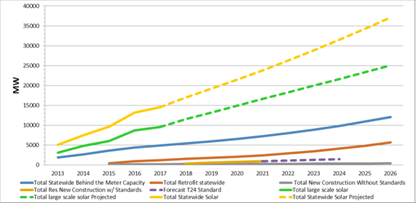
Question
Would the 2019 Standards PV requirement create or exacerbate a market where California has too much solar capacity on mild and sunny days?
Answer
The expected increase in PV installations due to the 2019 Standards PV requirement is equal to only 1.1 percent of total existing statewide PV capacity. The other 98.9 percent of the PV capacity installed in the state–including utility-scale PV systems, nonresidential buildings installations, and PV installed on existing homes–is unaffected by the new requirements. Further, because the rate of growth for utility-scale and voluntary, behind-the-meter capacities is steeper than the residential new construction rate, residential new construction will make up a smaller percentage of total statewide PV capacity in the future.

Moreover, the 2019 Standards require PV systems sized to offset just the annual electricity consumption of a highly efficient dual-fuel home. The result is a modest PV size (2.8 kW for a typical single-family house) when compared to the average PV size installed on existing homes (about 7.2 kW for a typical single-family home). PV for existing homes is unaffected by the 2019 Standards. Overgeneration that causes a homeowner to sell electricity back to the grid is discouraged by both net energy metering rules and by the 2019 Standards.
The 2019 Standards include compliance incentives for demand response and grid-harmonization measures, such as precooling, thermal storage, and battery storage systems. These complementary technologies maximize self-utilization of PV electricity generated onsite and minimize hourly exports back to the grid, and as they come into common use, they will benefit distribution systems and enhance local reliability.